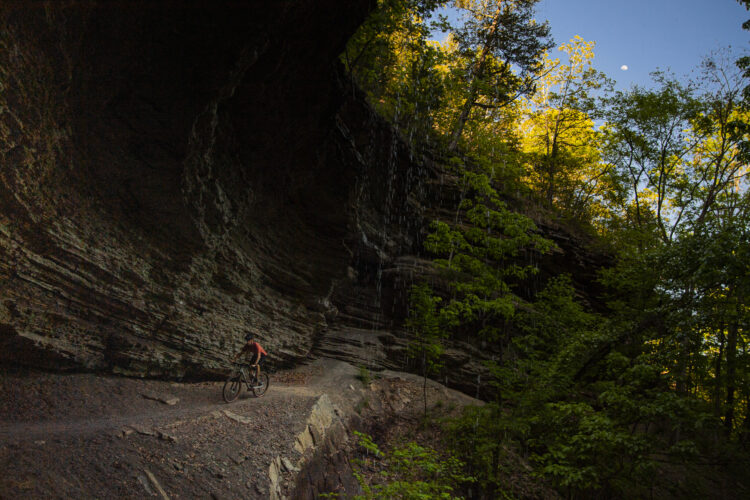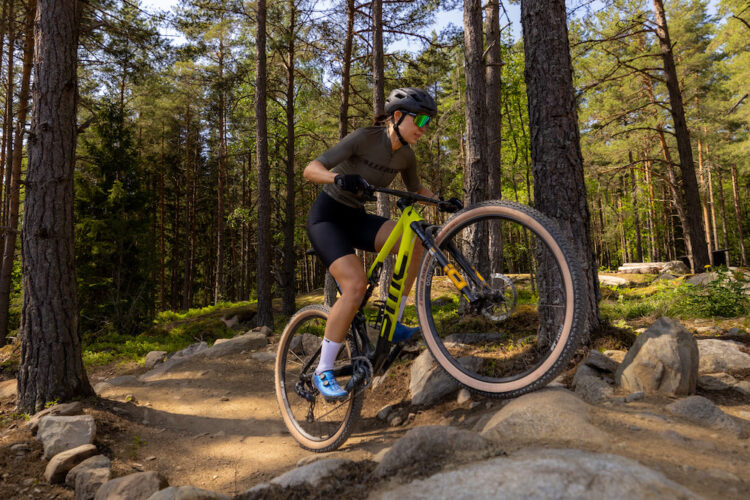
There are two good ways to ruin a perfectly good ride, and neither of them have anything to do with your bike: bonking and cramping.
Bonking is the state usually associated with a lot of pedaling or climbing, resulting in shakiness, being lightheaded, and feeling like you need to dump a refrigerator in your mouth happens when you’ve depleted your body’s available glycogen stores. You have burned through your available blood sugar and stored glucose without consuming enough to replace it for the energy you need to continue cycling.
Cramping on the other hand can be separate from bonking and usually happens when you haven’t replaced as much of the electrolytes as you’ve lost and your muscles—for cyclists it tends to be the quads and calves—start to seize and lock up. Vierling also adds that cramping happens when riders push beyond what their bodies what they’re used to or trained for.
Ok, we jumped the gun. There’s one more thing that can spoil your endurance endeavor: attempting to hydrate or fuel yourself only to have it come right back out. That’s what happened to the founder of Tailwind Nutrition, Jeff Vierling, and led him to start the company.
Vierling had just crossed the finish line at the Leadville 100 for the first time. He got off his bike, went straight to a trash can and threw up his breakfast from 13 hours earlier.
Simpler calories are better
After enduring a handful of “nutritional fails” as Vierling calls it, Vierling decided to try concocting a mix of his own. He worked in tech at the time, and had been trying just about every kind of mix and solid fuels out there before and during races.
Though Vierling came from a different background, he grew up under two physicians and felt comfortable wading through sports nutrition literature. Vierling found some guinea pigs to try out the mix and the first recipe was a success.
“Hey this is the best stuff I’ve ever used, can I try some more?,” people asked him. “I was making them in the kitchen in the KitchenAid, and meeting people in parking lots and handing out baggies of white powder. Quite literally,” said Vierling.
When Tailwind launched its Endurance Fuel in 2012, Vierling’s mission was to come up with a mix that fueled and hydrated endurance athletes without causing undue gastrointestinal (GI) stress. The more complex the food an athlete is consuming the harder it is to digest, the more likely an athlete is to have problems, Vierling says.
But it’s not necessarily an easy fix. Even at moderate levels of exercise, athletes are burning hundreds, if not over a thousand calories per hour, but the body can only absorb around 400 calories per hours, said Vierling, putting endurance riders in a sustained calorie deficit. Though some people can train their guts to absorb more calories, it’s an intensive process which takes time, and absorbing 200-300 calories an hour is a more likely range for athletes.
Under the stress of exercise, the body pulls blood flow away from the internal organs and sends them to your capillaries, muscles, or extremities and away from the digestive system. If you’re going to eat during endurance events, it’s best to make it as easy as possible on your body, hence the plethora of simple sugar heavy goos, gummies and drinks out there.
A lot of sports drinks use maltodextrin, a processed chain of sugars that takes work to digest compared to even simpler sugars which can be absorbed more quickly, like dextrose or sucrose. Introduce fats and proteins during exercise at your own risk, Vierling suggests. Both have their place for athletes, but not during intense activity.
“Generally speaking, as intensity goes up and as duration goes up, your ability to digest goes down.” If a food isn’t absorbed or digested, then it’s often passed on to the bacteria-rich large intestine, where the the meeting of both can cause GI issues.

Don’t skimp on calories with your hydration mix
As noted above, carbs and electrolytes go hand-in-hand when pushing yourself hard on the bike to avoid both bonking and cramping, but there’s more to it than that. Vierling mentioned that adding sugars with electrolytes opens up a biological pathway to help people hydrate faster.
There are transport mechanisms in the small intestine and they act like pumps, grabbing sugar molecules — glucose or fructose — along with sodium molecules when they’re actively suspended in water, and move them across the intestinal barrier into the blood stream.
With glucose, it’s sugar that can be burned almost as quickly as it’s ingested. By pumping sodium molecules across, the sodium attracts water from pores in the small intestine, giving you even more water to hydrate with than if you were just drinking water alone. This is known as sodium glucose cotransportation.
In short, by combining sugar with electrolytes, your body is able to hydrate more quickly than if you were just drinking water alone. Vierling adds that if you’re consuming a mix like this, with water, sodium, and sugar, it’s really all you need to stay active for long periods.
“Basically if you give your body [those three things], then you don’t really have to digest anything and that became the basis of endurance fuel.”
Sugar-free electrolyte mixes might still have a good mix of hydration properties and save you calories, but unfortunately they will still hydrate at the same rate as regular water because they don’t activate sodium glucose cotransportation.
Lastly, electrolytes
There are two electrolytes that athletes need to consider first and foremost, Vierling says: potassium and sodium, though it’s still good to get in healthy amounts of calcium and magnesium too. Sodium is important, since water follows sodium around the body and helps move water in and out of cells.
Potassium is important for electrical conductivity in the body, sending signals to the muscles and the heart. Cramping can be a result of interruptions in electrical conductivity as well as a number of other things. A lot of us get our electrolytes naturally through food intake—milk, fruit, salty snacks, or whatever it may be. It’s hard not to consume electrolytes, but they are still important to supplement on longer rides. As for shorter rides, water is still the most important thing to consume since you’re losing water more quickly than electrolytes.
“Generally speaking, if you’re going for a shorter distance, the more dominant use is really just to help you get the water in,” adds Vierling about drinking a hydration mix. “It’s not so much (electrolyte loss) that you need to replace.”
When you dehydrate, you’re losing more water from plasma and concentrating the salt content, making it even harder for you body to push around blood for muscle function and cooling. Sure you can set reminders or write yourself notes to drink water or consume electrolytes, but your body does a pretty good job of reminding itself.
“When you start thinking, I really am craving something salty, that’s sort of an indication that you’re probably behind on both water and electrolytes,” said Vierling. “It’s like our lizard brain, saying hey how about a little bit of salt, and maybe throw in some good carbs and then drink a bunch of water.”
A few small things to remember
A lot has changed in the drink space over the past several years. Mountain bikers have been mindful of their hydration behaviors forever, but it seems America as a whole is trying to hydrate more than ever these days. Liquid I.V., Nuun, and other mixes are widely available and widely sold at nationwide grocery stores, not to mention drinks like Liquid Death, the canned water with electrolytes in its ingredients. Unilever, Nestle, and other mega-corporations have been investing in the products. Better than sugary sodas, right?
Vierling says it’s best to keep it simple, even if the drinks are promising a lot of athletic benefits. Caffeine is the only supplement proven to actually enhance performance. Other vitamins, not so much. He likens it to the necessities for a car.
“You need gas, oil, coolant, but if you throw octane booster in, it may or may not do anything,” he said. “That’s where most of the supplements live in terms of scientific efficacy.”
So, keep it simple. When exercising, your body needs electrolytes, water and calories, and combining all three in a drink mix will help your body sustain itself better.
Endurance ride checklist
- On rides, drink before you’re thirsty. Eat before you’re hungry.
- Don’t forget electrolytes and calories on long rides. Combined with water, they will hydrate and fuel you faster.
- Eat simpler carbohydrates during exercise. Save the protein for afterward.
- Water is the most important nutrient to replenish
- Listen to your body when it wants salt, water, or food.
- Take in carbs, water, and protein for proper recovery after a hard workout.






Awesome article!
It seems like you focused on only Vierling, but Tailwind is the best replenisher I’ve found. Works great and you don’t get sick of it (or on it). We’re doing a 192-mile, two-day rugged bikepack trip in the national forest this weekend and it will be in my bottles.
Tailwind is great. We don’t really do supplement reviews anymore, but this was a great way to learn about the product and what makes it functional. I’ve really like the taste and Tailwind’s functionality though. Good stuff for sure!
Agree about Tailwind, as I got older their recovery mix was a gamechanger in doing successive days of hard riding. And the vanilla tastes pretty good too!